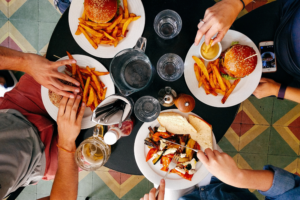As we conclude our habit formation series, let’s focus on the subtle but powerful role our environment plays in our daily routines. Whether it’s your living room or an office, the spaces you inhabit influence your behaviors and, ultimately, the habits you cultivate.
If you’re just tuning in, here’s the rundown: Our journey began with learning how to leverage habits to achieve personal goals. We then explored the interplay between our intentions and behaviors and their role in successful habit conditioning. In our third article, we examined the mechanics of habit formation. Most recently, we discussed strategies to integrate these habits within our routine (or vice versa).
In this last piece, we examine how environments impact our habits. From breakfast in your kitchen to how you unwind at a park, every setting has the potential to either foster or hinder your progress. Since you spend a considerable amount of time at home or work/school, inspecting these environments can alter the landscape of your daily habits.
What is “environment,” and how does it affect our actions?
As you’ve learned, a habit is an automatic behavior that engages via a stable cue. One of our ongoing examples has been of entering the bathroom in the evening and immediately brushing your teeth. Entering the bathroom is the cue to initiate the action. The bathroom is the environment, and guess what? You won’t brush your teeth if you don’t enter the bathroom. Habits depend on these environmental contexts, which are the stage for our subconscious firings. Therefore, knowing and understanding your environment is a big deal.
When I say environment, you probably think of your home, neighborhood, or city. You may think of the nature that rests out your front door or even consider other consistent locations such as work or school. Your environment is any physical space you occupy. Environment locations are determined by a range of needs and factors, from emotional to financial. They are homes, cities, countries, jobs, neighborhoods, grocery stores, parks, family homes, and travel.
However, your environment is not just about the physical spaces you inhabit, but also the things within these spaces. Your clothes, technology, and the books surrounding you all contribute to your environment, reflecting your tastes and interests. Even the size of your dishes or car (or if you have a car) can influence your daily environment and how you feel in that environment. It’s not just the places, but also the people and things that make these spaces uniquely yours.
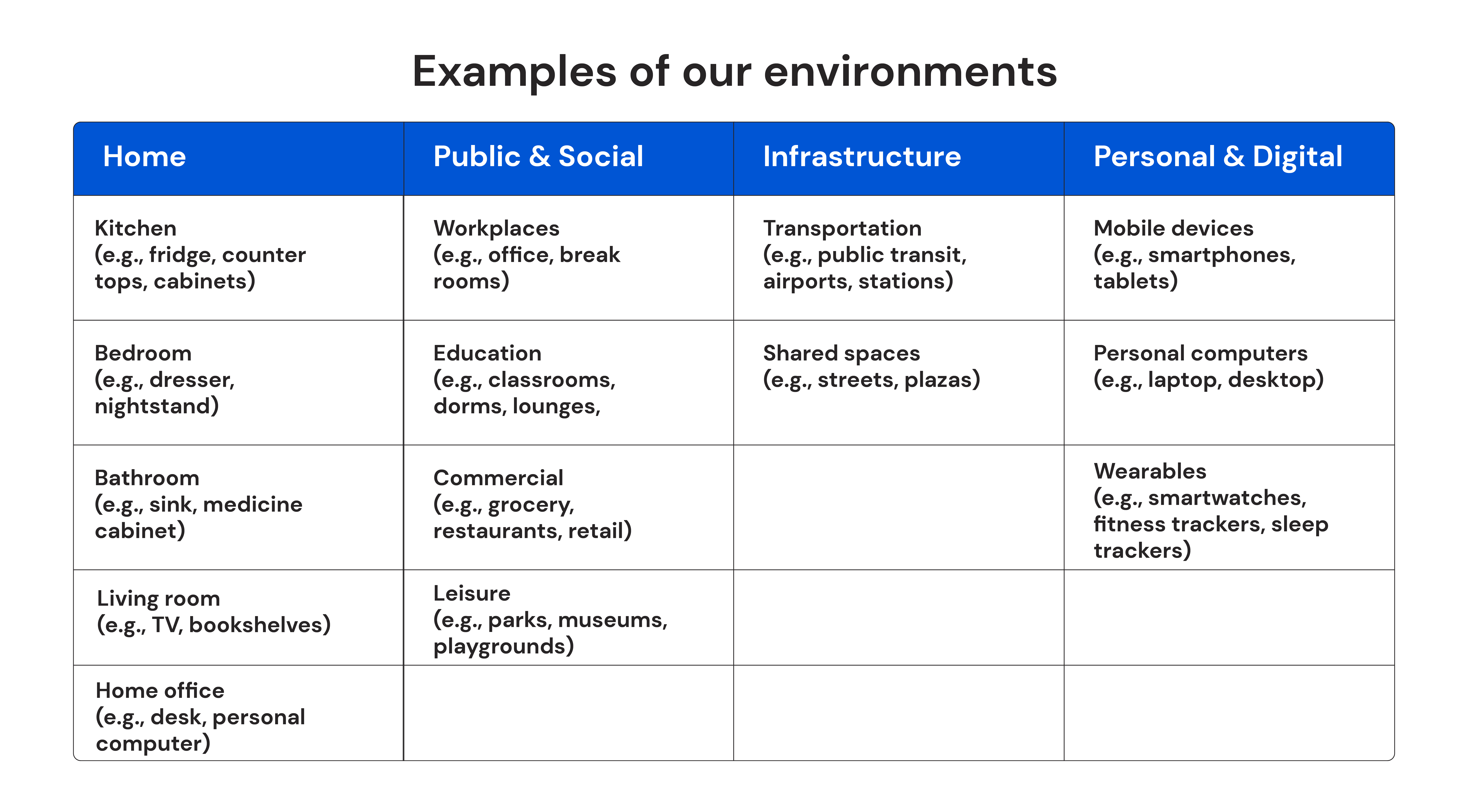
These spaces can be drastically different from one person to another. In obvious ways, those with fewer financial means have a drastically different daily environmental experience than those with more economic means. Other countries, cultures, temperatures, or access to food or facilities will create a different daily ecological experience.
Because of these varying environmental factors, we should understand how a neighborhood can encourage walking or support physical activity. Or, how a lack of a stable and supportive environment can be a barrier, just as having social support in your environment can assist desired behaviors. In this series, we’re diving into how habits can support your health behaviors, and a key piece of that puzzle is our environment.
Let’s get a little deeper into why.
Navigating the terrain of choice architecture, nudging, and stimulus control
Research in behavioral economics and psychology frequently involves observing or manipulating environments to study choice architecture — how the organization and presentation of options and our environment influence decisions. Everyday examples include grocery stores eliminating plastic bags to encourage the use of reusable ones, thereby reducing waste, or putting stairs with footprints to encourage more stair use. In nutrition, there have been attempts at informing consumers about the amount of calories or portions for customer awareness.
Choice architecture refers to shaping a person’s environment, including how options are presented and organized. Nudging is a concept within choice architecture that subtly guides people toward a particular choice without restricting their options. Choice architecture acknowledges that people often rely on automatic decision-making (habit and process routines) that account for human cognitive biases and shortcuts. Therefore, choice architecture aims to nudge people toward more beneficial behaviors.
To clarify our discussion, I want to differentiate between choice architecture and stimulus control. Choice architecture concerns how options are arranged and presented, influencing decisions through the structure of choice itself. On the other hand, stimulus control involves modifying the external cues of existing habitual behaviors.
To illustrate the difference, let’s consider this example of buying fruit in a grocery store.
Researchers might place fruit at the end of every aisle when applying choice architecture. The strategy here is to increase the visibility of fruit and hope that greater exposure prompts more impulse purchases, regardless of existing shopper habits. Conversely, when focusing on stimulus control, the approach starts with understanding shoppers’ habitual behaviors — such as tendencies to make impulse purchases in certain store areas. Now that researchers know their shoppers’ habits, fruit could be strategically positioned in these areas to leverage existing habits, enhancing the likelihood of fruit purchases.
Both methods aim to influence behavior, but choice architecture manipulates the decision-making environment without assuming pre-existing habits. In contrast, stimulus control directly targets and utilizes existing habits for desired outcomes.
As with other aspects of behavior research (like we discussed with habits and routines), definition lines can bleed, and some researchers use one term when it’d be more technically correct to use another. As we go along, I’ll note the differences if needed, but my point is not to get too caught up with the word usage details or even the overall effect outcomes. Ultimately, these articles aim to funnel advice so that you can set up environments (home, work, routes, etc.) to have better outcomes and glean lessons about your habit conditioning.
A systematic review by Landais et al aimed to evaluate the effectiveness of micro-environmental choice architecture interventions that encouraged physical activity or discouraged sedentary behavior in adults. Out of 9609 records, 88 studies met the inclusion criteria, with a predominant focus on interventions designed to increase physical activity, particularly stair use. The outcome showed that 68% of these studies reported a positive effect when the interventions were active. However, the effectiveness dropped to 47% post-intervention, highlighting the need for continual environmental cues. Meaning we always need to consider our environment and the role it plays, especially regarding habits.
In analyzing a broad range of nudges, we find that default nudges — such as automatically enrolling employees in retirement plans or organ donation registries — tend to be pretty effective. However, the effectiveness of reminder nudges, like vaccination reminders, can be inconsistent. Therefore, it’s important to consider your specific needs and what will most benefit your environment and lifestyle when implementing these strategies.
Take home? There is decent evidence to suggest that manipulating an environment can influence outcomes. However, the details matter: the type of nudge and its continual presence are important in determining how effective the environmental change will be.
Beyond the obvious: Environmental influences on decisions and habits
In a later section, I cover what I think are the more “obvious” factors of choice architecture. For now, let’s look at a few complex angles of how our environment influences our decision-making to (perhaps) make you think differently about what makes up the “environment.”
We start with a study that questions conventional advice you might have heard about hunger states in shopping environments. You’ve likely listened to the advice not to shop when you’re hungry, as it’s believed you’ll buy too much or opt for unhealthy, calorie-rich foods. But is it really that simple? Cheung et al delved into this question, examining whether hunger and the cues we encounter lead to poorer nutritional decisions.
Two different studies were included in the experiment, and both looked at how participants chose food while indicating their hunger level. The first study showed that people who felt hungrier also felt less able to control their actions. However, the decrease in self-control did not necessarily lead to the selection of less healthy food options. Essentially, just being hungry did not automatically make people pick unhealthy foods.
The second study found that hungry participants were likelier to choose less healthy foods than those who were not hungry. Now, the first study was conducted via online shopping. The second study was conducted in an in-person environment in a cafeteria. In the first study, the participants did not have a high hunger rating; in the second, they had higher hunger ratings. Additionally, when the hungry participants of the second study were given information about what others preferred (social proof heuristic), they were just as likely to choose healthy foods as those who weren’t hungry.
Why is this interesting? Well, for a few reasons. One, it suggests that while yes, “unhealthy” food selections can be made when hungry, it might be more correct to say that we seek vetted or easier selections of food when our resources are low. The outcome suggests that in states of hunger or tiredness, our priority might not be indulgence but rather the convenience of decision-making. These findings align with the depletion model of self-control, highlighting our preference for easy choices when our cognitive resources are low.
Other studies have shown similar things (here and here). So, while it’s still possible that you could buy “worse” items while shopping when hungry, chances are it’s the “easier” items you’ll lean toward. How can you use this knowledge? If you anticipate a busy weekend, consider preparing a meal in advance or buying healthy pre-made frozen meals that can be easily reheated when you’re exhausted, avoiding temptations that might throw you off your plans. Essentially, establish a system within your environment, whether at home or elsewhere, that supports your choices when your willpower is at its lowest.
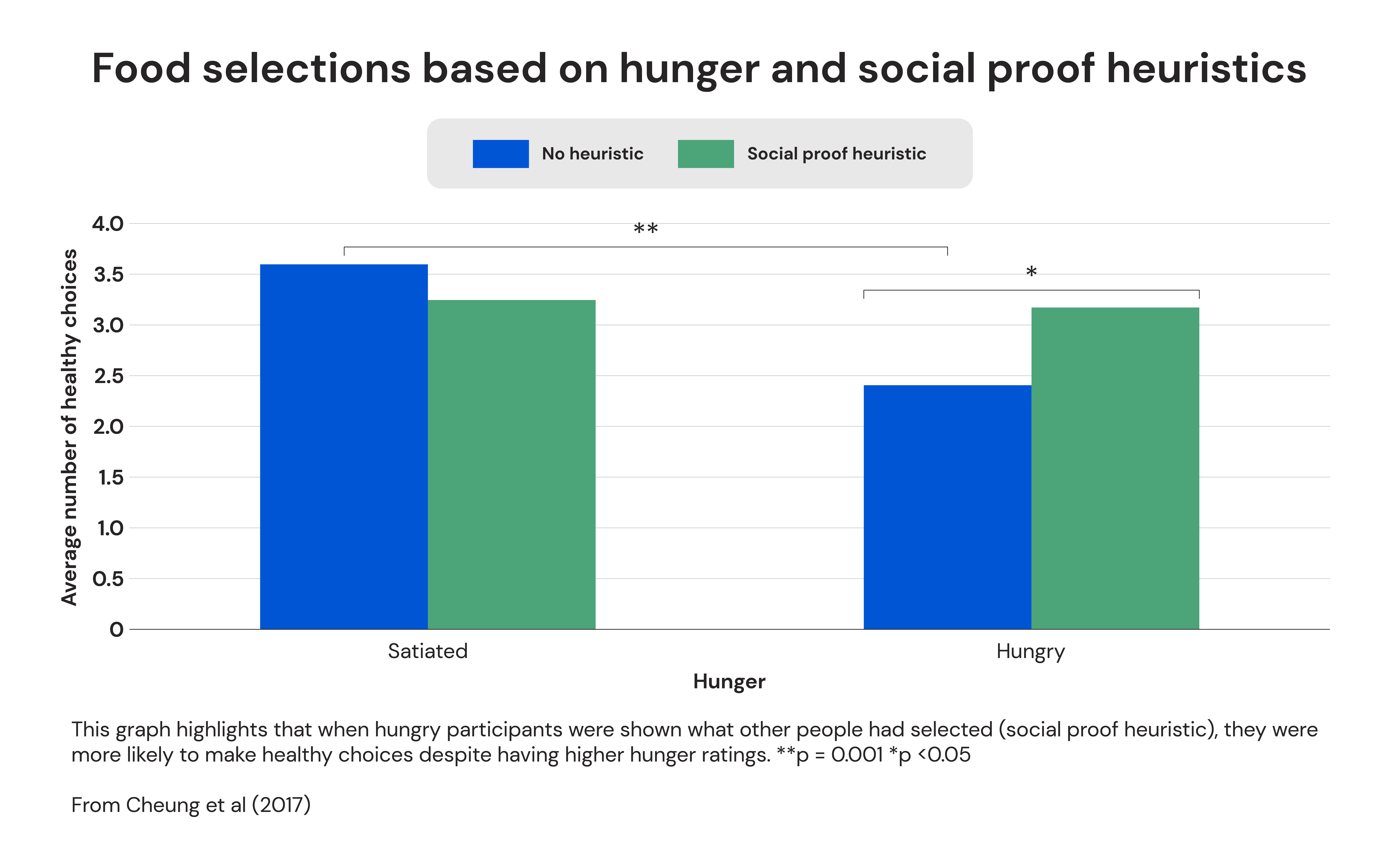
Lastly, this study could also suggest something about the importance of the people in our environment. Having social support makes it easier to make choices that align with our health and goals. And while we might not always think of people as part of our environment, they fill the spaces of our daily lives. Where possible, surround yourself with people who support your habit goals.
What’s easier to control: Our emotions or our environment?
To change, we should have intentions and a solid foundation of who we want to be and what we want from life. However, one of the reasons I like habits (and why I specifically focus on the environment) is that even with the best intentions and desires, we can still fail to launch. Therefore, if we engineer our environment, we can improve our odds.
A two-week study by Elliston et al, conducted with 61 adults, examined the complex reasons for eating behaviors, particularly snacking. The researchers wanted to see how situational cues, social eating events, emotions, or distance to shops affected people’s snacking behavior. What I liked about this study is that the researchers focused on the natural environments of the participants’ lives and gained insight into how they responded to their familiar and known circumstances.
The study’s findings revealed that immediate physical and social environments impacted participants’ snacking habits most, outweighing personal motivations or intentions. When examining the factors that influenced snacking, negative affect (emotions), proximity to snacks, and the presence of others eating emerged as the most influential.
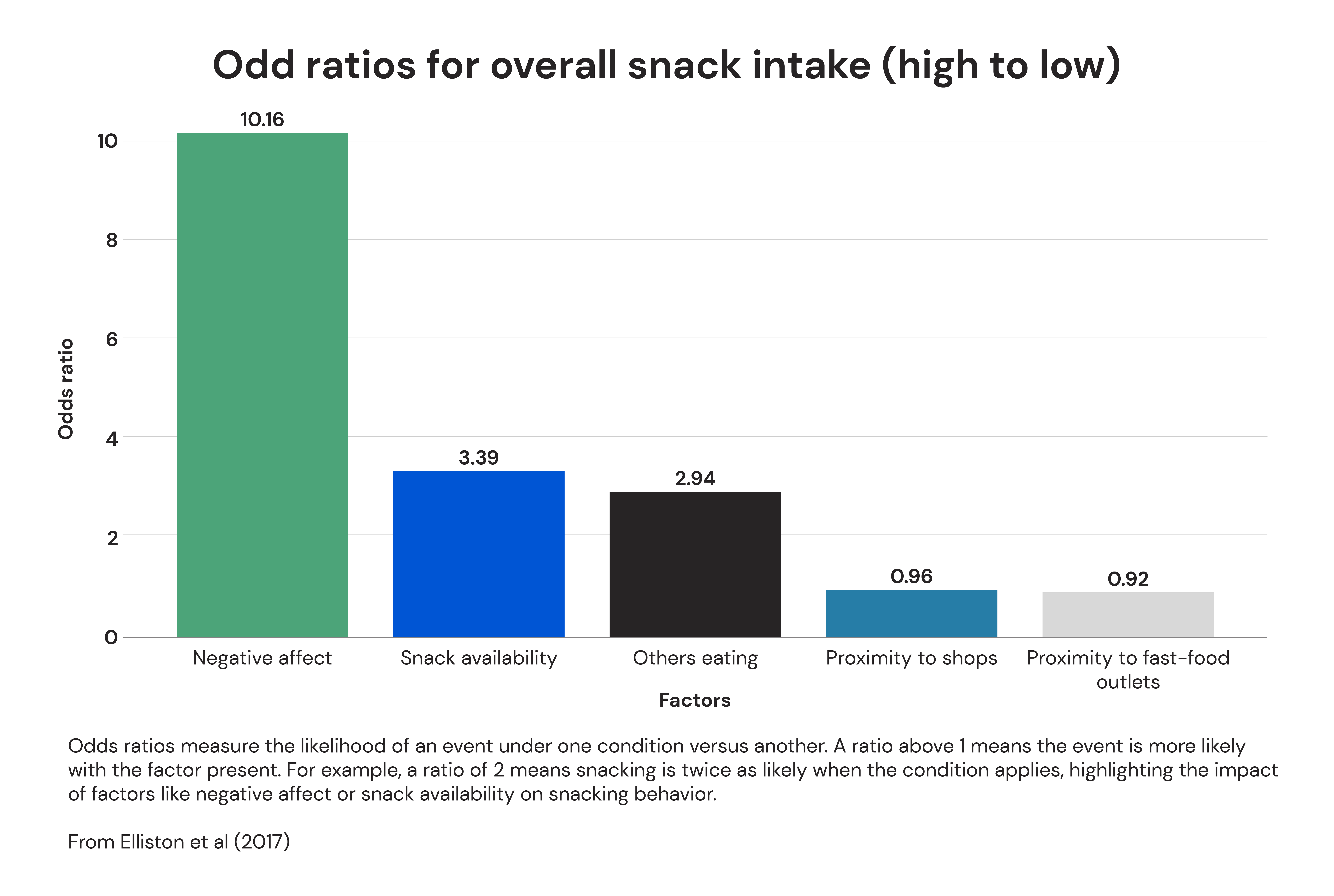
You might look at these graphs and think, “Gee, maybe we should be working on emotions?” However, that is kind of my point. Emotions are going to come. You will face situational experiences where you want to eat because you are bored, happy, sad, annoyed, or simply craving hedonistic pleasure. It would take far more than a five-article series to discuss why you’d want to eat emotionally, let alone help you fight against it. And who knows, maybe that will be a 10-part series someday. For now, we can control our environment. Focusing on adjusting the environment — like reducing snack access — is a more direct and simplistic approach than dealing with the much more complex reasons why we comfort eat in the first place.
Additionally, while the negative affect was linked to an increased likelihood of snacking, the availability of snacks played a crucial role in the type of snacks consumed. Low-energy snacks (such as fruits and vegetables) seemed to slightly decrease the response to snacking compared to high-energy options. Meaning that if snacks are present, opting for lower-calorie options could be more beneficial.
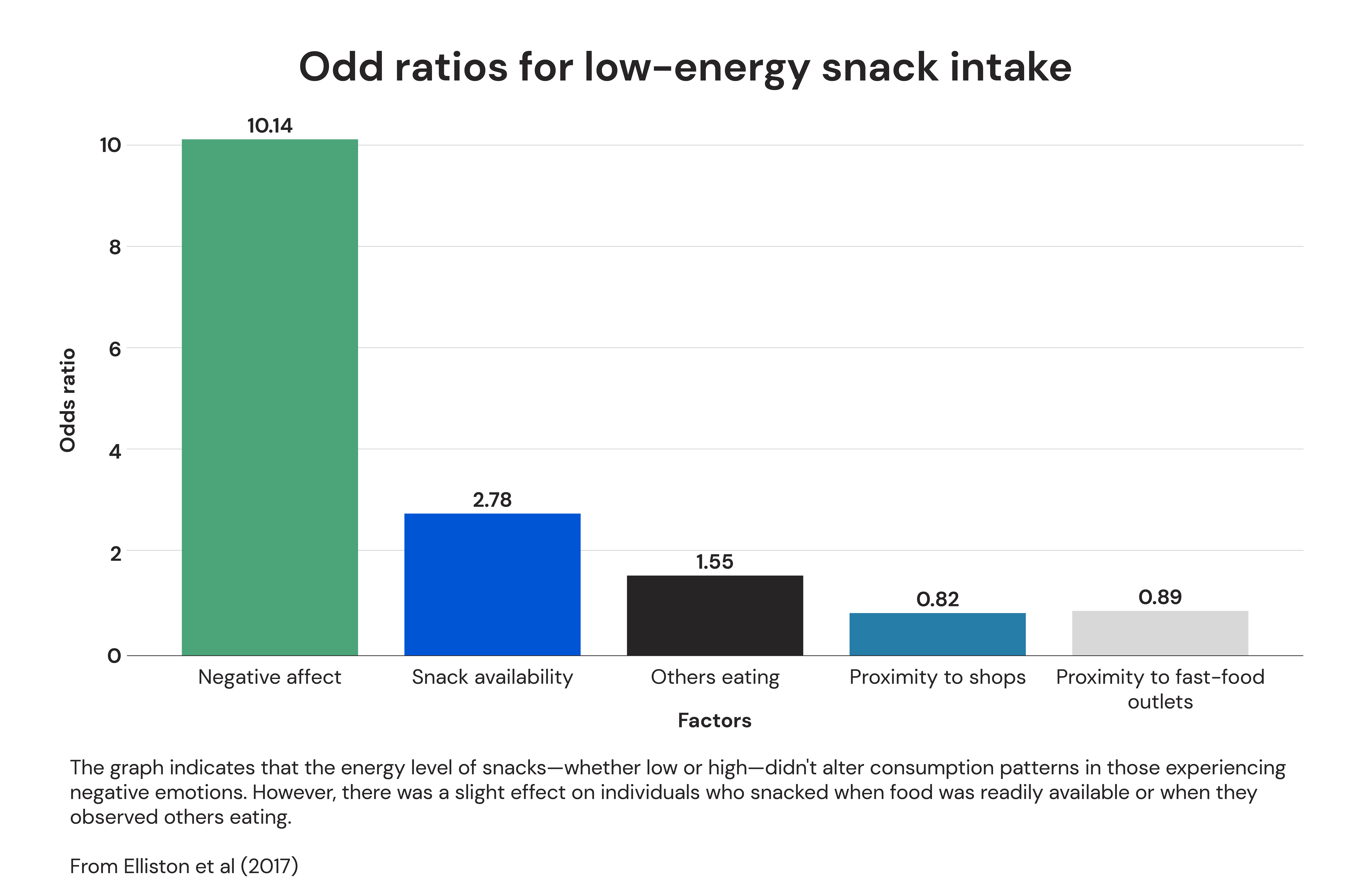
Do these things apply across the board with other types of behavior outcomes? Well, we’ve seen that having habits in place to support or aid physical activity is important, even without the presence of intentions. Because, again, while intentions to do something are great, we are more likely to be consistent if we have helpful habits in place. To encourage activity, researchers have tested putting footprints on staircases to encourage stair usage and using music or art to create environmental prompts.
Can we manipulate our environment to “prompt” us enough to help our desired habits? More so, can these prompts break existing habits?
One study by Gardner et al aimed to make people more aware of their sitting environment by sending workers a prompt to reduce sitting. Every 45 minutes, the workers were encouraged to take a break from sitting. The “active prompt” allowed participants to ignore prompts, while the “passive prompt” only allowed postponing the break. The study found minor reductions in self-report measures of “lack of awareness” and “lack of control” in sitting automaticity. Therefore, as the participants became more aware of their sitting, they gained more control over getting up from sitting.
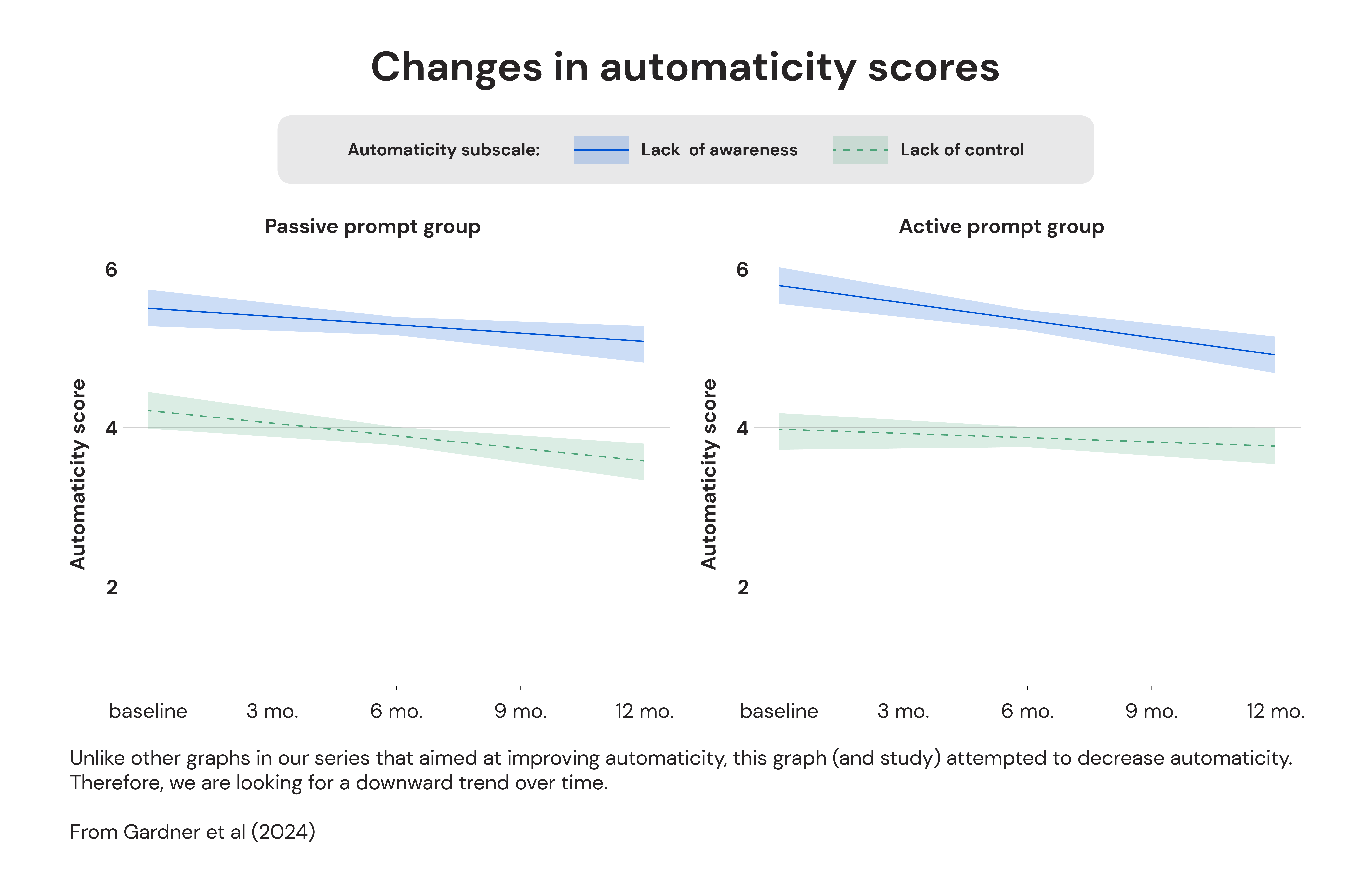
The rate of decline in sitting awareness reinforces much of what we know about the difficulties in breaking existing habits. While they technically succeeded in increasing sitting awareness (decreasing automaticity), it didn’t come fast or easy.
5 ways to apply choice architecture research to our goals and habits
So, we’ve seen a few studies examining how our environment can affect our behaviors and habits. We also learned that our environment is more than just spaces; it can be objects, technology, or social dynamics. Let’s close this article out with five tips for applying what we’ve learned.
#1 Remove counterproductive cues and general temptations
In my first obvious bit of advice, remember that your environment and objects in your environment are part of the cue. Therefore, removing yourself or particular objects from a cue context environment can (quite literally) stop the trigger of undesired habits.
Obviously, I’m not advising that you remove the kitchen from your home if you have a late-night snacking problem. But you can remove the snacks or place them in a harder-to-reach place that would require more conscious thought. You could also buy lower-calorie snacks or ensure you have food that needs to be prepared before serving (raw meats, frozen vegetables, uncooked rice, etc.).
For a few more examples, let’s say you’re trying to walk more, but you tend to watch too much TV in the evening. You can avoid entering your “lounge zone” until you’ve hit your activity goals, or you could even remove the TV altogether until you’ve solidified the habit (this also ties in with #4).
With counterproductive or undesired habits, focus on avoiding the cue from initiating in the first place. Avoiding cues can involve changing your routines, setting personal boundaries, or even temporarily changing your physical environment. As we’ve seen, momentum is difficult to halt, so one of your best weapons is not letting it start.
#2 Give as much support to the cue you’re trying to condition (or break)
The consistency of our environment and the stability of cues drive habit formation. With habits, we aim to create a setting where our routines and behaviors have a strong chance of automaticity. Small acts, such as maintaining a clean living space or ensuring you have the right foods, can lay the groundwork for building stability. If trying to train a nutrition habit, eating meals in the same place without distractions (such as TV) helps reinforce and focus the habit conditioning.
Supporting habit formation goes beyond the basics and often requires small and significant personal investments to overcome barriers. For instance, investing in meal prep containers can foster the habit of preparing healthy meals in advance, directly countering the allure of fast food. On a larger scale, committing to a gym membership or purchasing home exercise equipment can be a significant step toward regular physical activity.
For support, consider things that directly affect your habits. For example, if you want to stop eating fast food for lunch, buy meal prep containers or lunchboxes to support that specific habit. If you’re trying to exercise more, this could mean purchasing a walking pad if you find going outdoors a continual barrier.
The goal is to pinpoint the factors that hinder or facilitate your habit formation and then take intentional actions to support your habits. Whether a minor purchase or a more substantial change, the aim is to eliminate barriers and provide the necessary support for success where possible.
#3 Make use of constructive prompts
Prompts can be visual, auditory, or even sensory. For example, a fitness watch might have a function that tells you to move after a period of stillness, or a water bottle might have measurements that let you know how much you have left to drink in a day. You can create visual cues that prompt exercise, such as placing a pair of running shoes by the door or laying out your gym clothes. Similarly, keeping healthy snacks at eye level in the fridge encourages nutritious eating habits by making healthy choices more visible and accessible.
What you’re looking to do is create reminders (and ideally repeating ones) of the habits you’re looking to nurture and condition. Even in your workplace, you can make small changes to alert yourself to your goals. For example, having a health journal on your desk or even decorative items that encourage a certain kind of lifestyle you want to lead can all be subconscious reminders of the habits you’re trying to achieve.
Lastly, apps or alarms are popular prompts you can engage with to support your habits. They often come in reminders, timers, notifications, or other “push” style services, sometimes called digital nudges.
#4 Eliminating choices can help narrow your focus
Essentially, choice elimination is creating an environment where there are so few options that the default wins. For example, you could remove all liquid calories from your home to support your habit of drinking more water. If you’re trying to achieve more physical activity, you could briefly remove one of your favorite seats and put a recumbent bike in its place. Another example is walking to get somewhere instead of driving.
Utilizing the default choice can be a little more intensive but can work well for people attempting to jump-start new habits. It should go without saying that they should be done in a healthy and supportive manner. In my own life, I’ll often walk instead of driving. However, I do so in areas that are safe to walk. It’s a great way to get steps in by default.
The point is that it’s perfectly fine to engage in more intensive default choices; just do so with your well-being in mind.
#5 Take extra note of your daily routes and patterns
While this tip intersects with supporting or removing counterproductive cues, I wanted to highlight the importance of our daily routes. Remember, habits are “triggered” by entering environments. When you physically enter an environment (say, the bathroom in the morning or your office break room), you start a chain reaction of subconscious responses. With route awareness, we want to have a heightened awareness of our surroundings and how our surroundings affect us.
How you move around a grocery store, if you take roads past pretty parks, or even how your kitchen is set up for cooking can influence the subconscious support or hindrance of your habit goals. I’m not advising you to overthink every movement, but consider your day and how your physical routes and patterns can be tweaked in your favor. For example, if you go out for lunch every workday, maybe you can instead eat at a park sometimes or meet up with a friend who is encouraging your new habits. These seemingly minor adjustments can lead to transformations in your day-to-day life, propelling you closer to your habit goals.
Wrapping up the habit series
If you’ve followed along with the entire series, you’ve taken in almost 25,000 words of research-supported advice on how to form and support your habits, goals, and optimal lifestyle. Let’s take a minute to remind ourselves of what we’ve covered thus far and condense it into some key moments.
- Our habits work automatically to assist us in finding more direct and less cognitively demanding actions for our routines and behaviors. However, that automaticity can work for or against our desired goals. Ideally, we work on conditioning our habits to work for us and decreasing those working against us.
- Once we’ve decided to address our habits, we must delve into the underlying behavioral changes necessary to make habits a reality. We should examine our intentions, understand our motivations, and devise if-then plans to bridge the gap between our intentions and actual actions, increasing our chances of success.
- Next, we learned how the technical mechanics of habits are formed – information that is needed when creating new constructive habits or breaking existing habits that are counterproductive to our goals. Chiefly, among the essential aspects of the technique is identifying specific cues and, if desired, keeping those cues stable over extended periods.
- Because habits require time to form, we must develop consistent and stable routines. New habits should be coupled with existing ones whenever possible to leverage their established patterns and enhance the likelihood of their formation.
- Lastly, we’ve learned that our environment’s role in habits is more than a stable place for cue context or execution. Environments can serve as a canvas on which our daily routines are painted, offering opportunities to lend additional assistance for our habits via prompts or ease of opportunity.
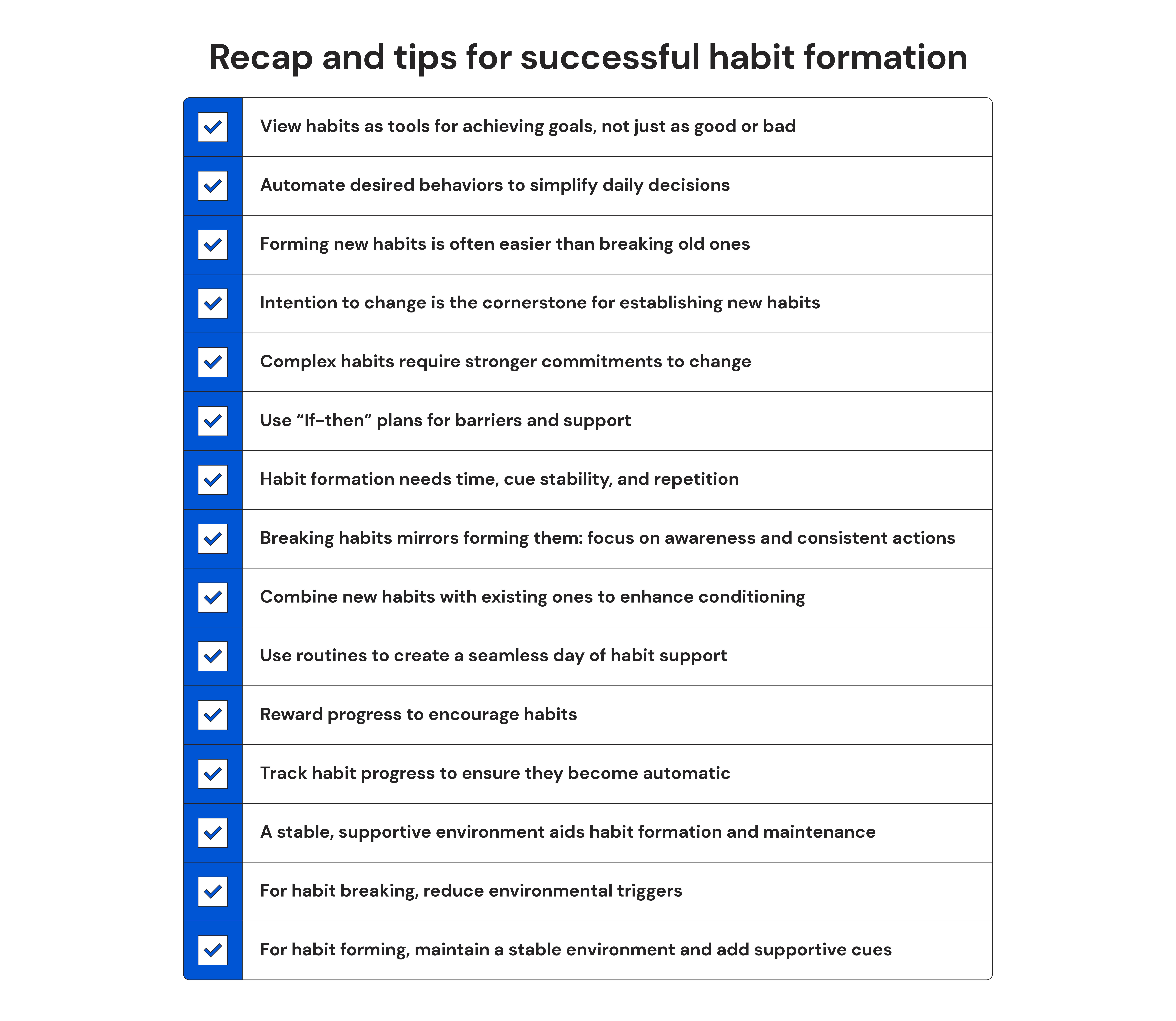
Homework assignment: closing out our case studies
We’ve reached the end of Casey and Riley’s case studies, but there’s still a little more work to do. For our final look, let’s apply the lessons learned about crafting a supportive environment to their current habit goals.
Case study 1: Increase physical activity via walking after dinner
Casey is a 44-year-old freelance graphic designer who works from home and wants to counteract a sedentary lifestyle by incorporating more physical activity into their daily routine. Their objective is to add a 30-minute walk after dinner each day.
List three ways you can alter your environment to support your goals:
- I don’t always enjoy walking in my neighborhood, but I love a nearby park, so sometimes I’ll take the extra 2 minutes to drive there and walk around.
- My treadmill can become a coat rack, so I’ll ensure that the area is always clean and ready.
- I think I’d use my treadmill more if I had a TV or gaming system in the room, so I will work on making the room more inviting.
Case study 2: Eliminate high-calorie snacking while watching TV/streaming
Riley is a 30-year-old account manager who tends to snack on high-calorie food while watching TV or streaming movies. Riley’s goal is to eliminate this snacking habit, hoping it will also help meet their goal of losing 20 pounds of fat.
List three ways you can alter your environment to support your goals:
- I will ensure the house does not have tempting and high-calorie items. If these snacks aren’t in the house, I won’t eat them.
- I’ll organize my refrigerator and pantry to present my healthier and lower-calorie snacks in the front to find them easier.
- On the weekends, I will leave my home environment and try new places, creating new rewards with my extra calories.
Your assignment:
At the end of each article, take a moment to document each insight lesson for your journey. For this article, try to answer the assignment questions that are also asked of our case study participants. Meaning, how can you improve your environment to make it more stable for your habits? Is there a way you can make your environment more supportive of your habits, even if not directly related to your cued actions?
Through this entire article series, I hope that looking at Casey and Riley’s habit goals has given you ideas for navigating similar goals. These case studies aimed to provide you with applicable and actionable advice rather than inundate you with theory only.


